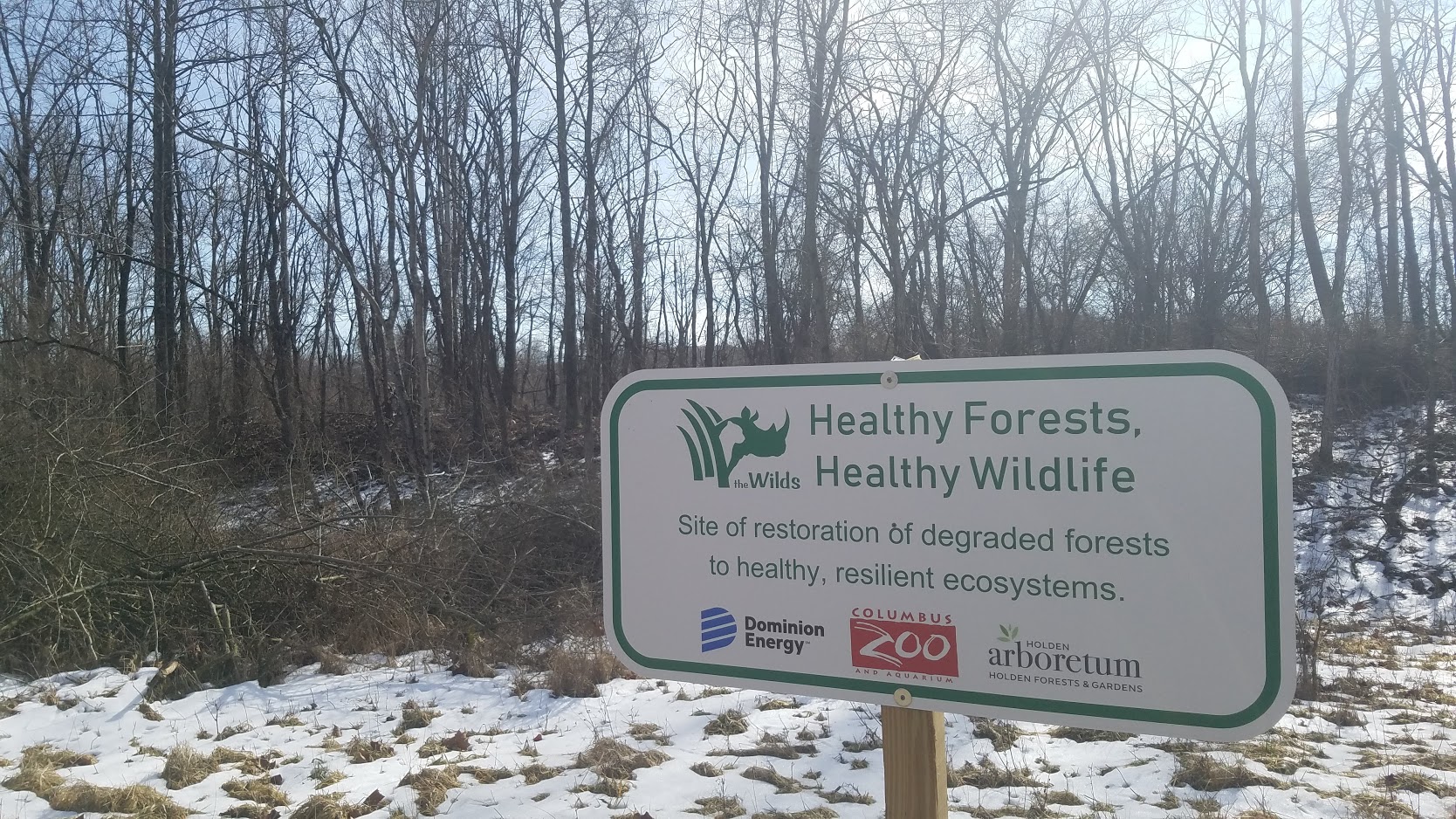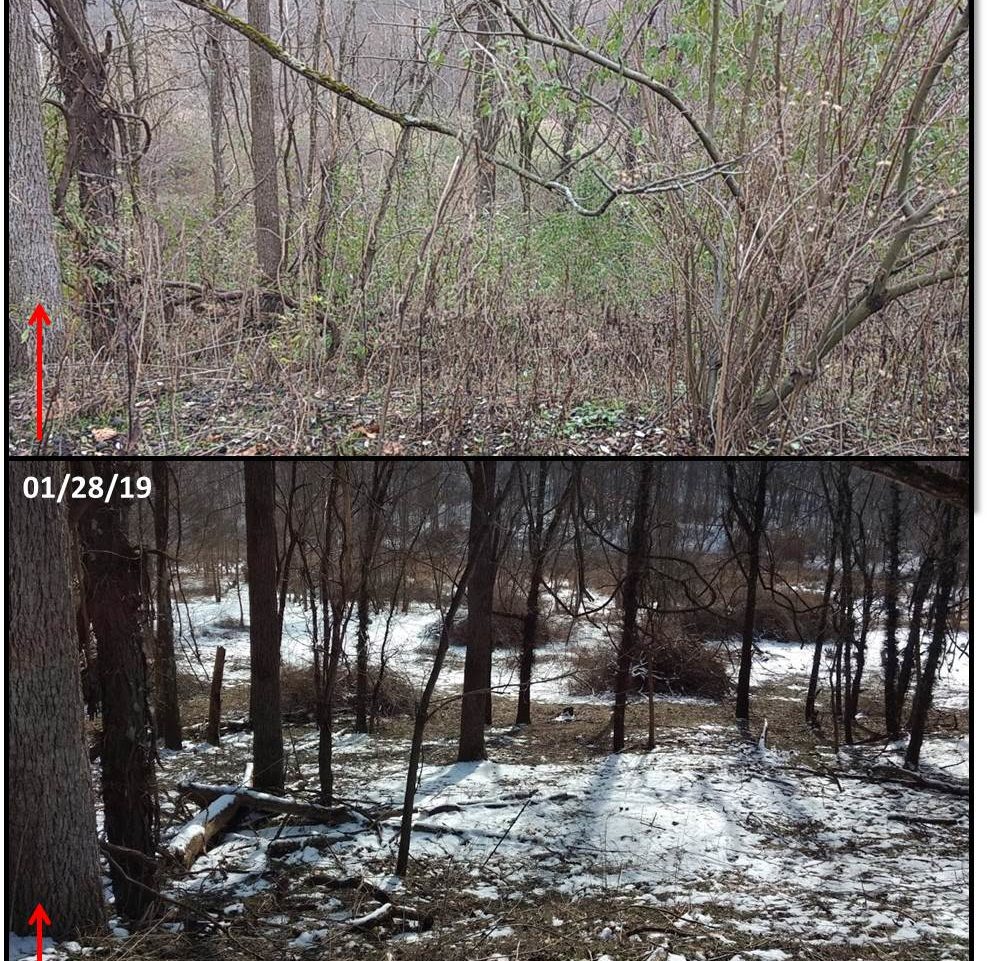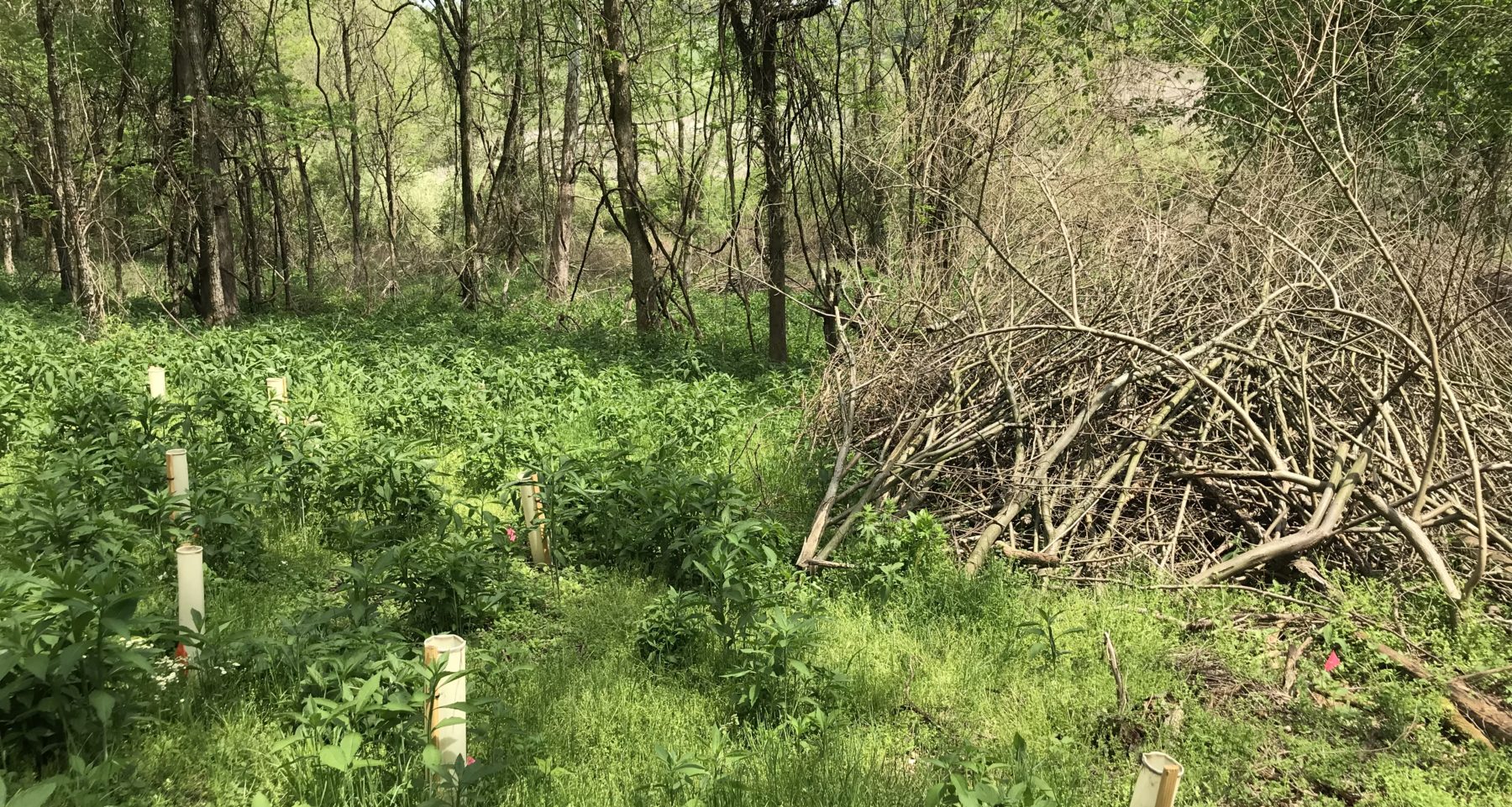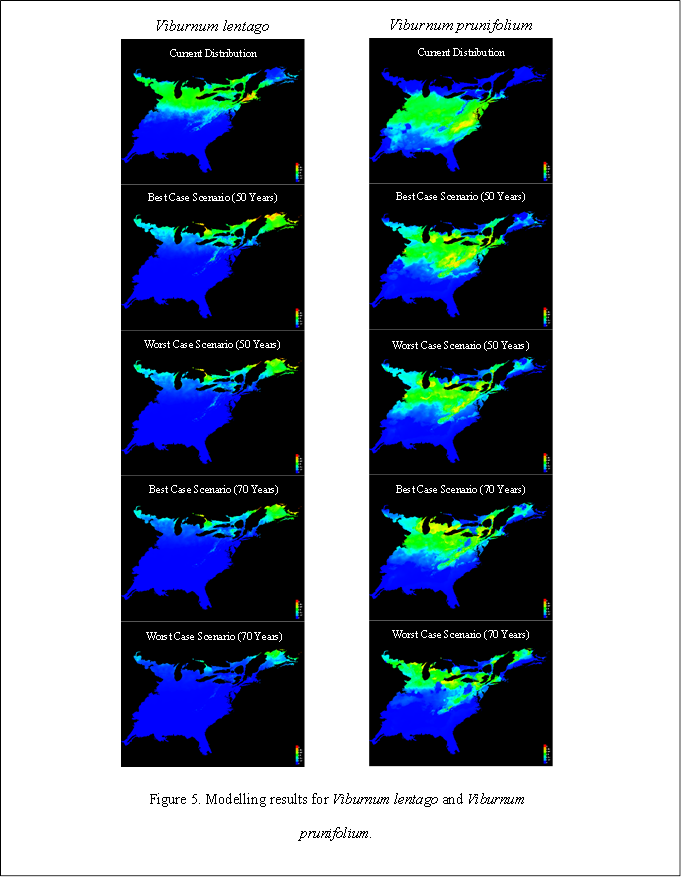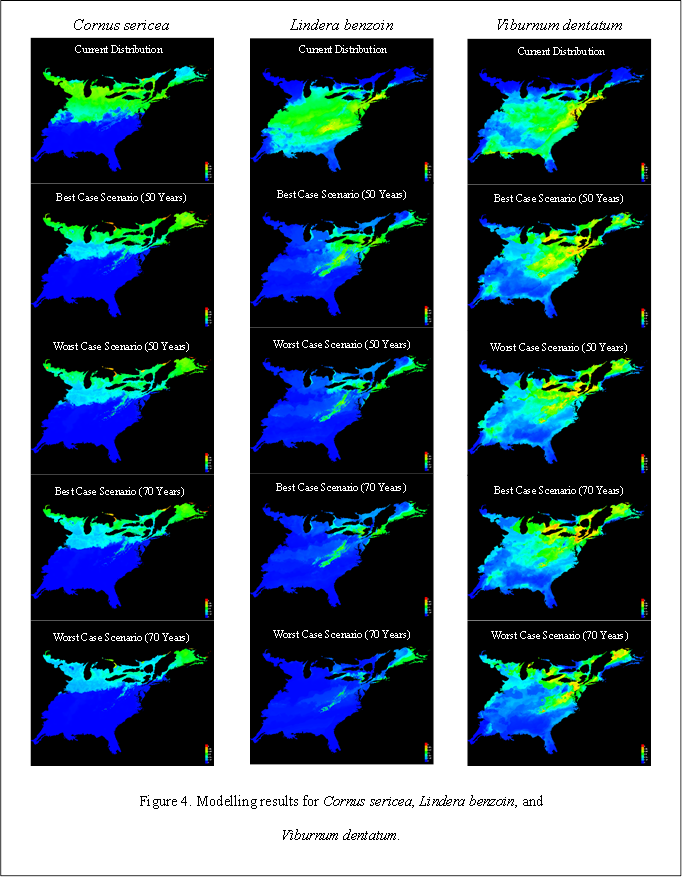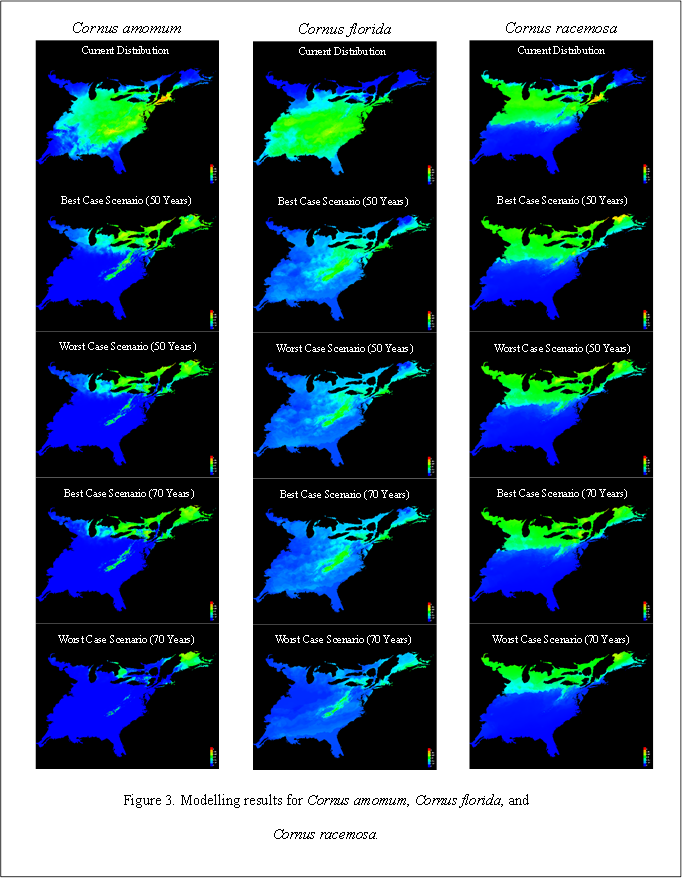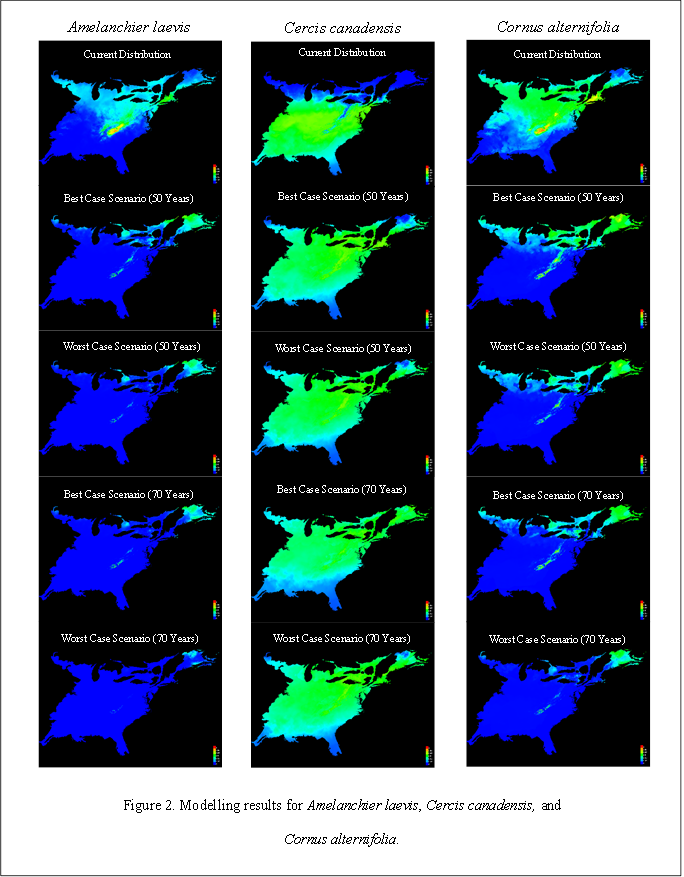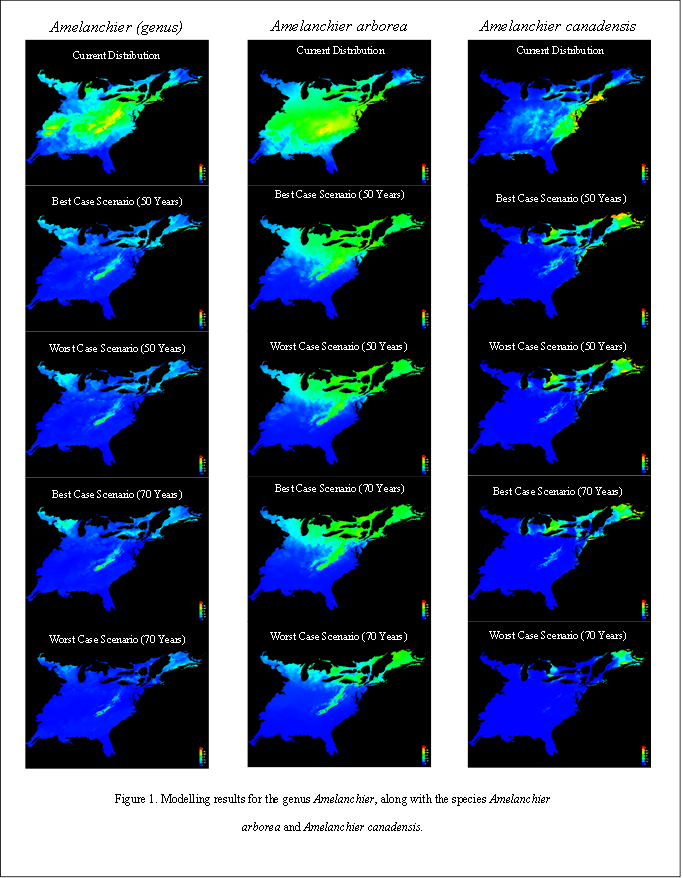Overview
The Wilds is a non-profit center dedicated to environmental conservation through science, education, and visitor personal experience. While The Wilds is most well-known for its exotic animals, most of The Wilds’ land is actually devoted to native conservation and restoration after agriculture and surface mining for coal in the late 20th century removed most of the region’s forests. Sections mined before 1976 tended to be reclaimed as forest and often have poorly developed soils with understories dominated by non-native species. The goal of this project was to try to restore the understories of these reclaimed forests. Between 2017 and early 2019, restoration efforts in our “Healthy Forest, Healthy Wildlife” area included invasive species removal, native plantings, and constructing animal shelters. All steps to restore this ecosystem involve local school groups as volunteers. This allows us to foster close relationships with high school students and teachers, teaching conservation through hands on experience conducting forest restoration. Building student’s skills will benefit the community, motivating locals to be engaged in conservation and ecology. This project will also benefit our wildlife; higher quality forests may increase wildlife presence. This project will serve as a pilot demonstration to improve reclaimed forest habitat for wildlife.
Quick Facts
Project Location:
The Wilds, Cumberland, OH, USA, 39.82948, -81.733024
Geographic Region:
North America
Country or Territory:
United States of America
Biome:
Temperate Forest
Ecosystem:
Temperate Forest - Deciduous, Temperate Forest - Mixed
Area being restored:
14+ acres
Project Lead:
The Wilds Restoration Ecology Department
Organization Type:
NGO / Nonprofit Organization
Project Partners:
-Dominion Energy, The Columbus Zoo , Arthur L. and Elaine V. Johnson Foundation, American Association of Zookeepers, Holden Arboretum, Green Forest Works, ArborGen
-Local Schools and volunteer groups in our area including: Maysville High School, Philo High School, Danville High School, Nicholas Liberty School, California University of Pennsylvania, New Lexington High School, Honda corporation, Ohio Stream Restore Americorps, AmeriCorps VISTA
Location
Project Stage:
Post-Implementation Maintenance
Start Date:
2017-02
End Date:
2020
Primary Causes of Degradation
Agriculture & Livestock, Climate Change, Invasive Species (native or non-native pests, pathogens or plants), Mining & Resource ExtractionDegradation Description
As a legacy mining site, ecosystems at The Wilds tend to be low diversity, low quality habitat. Compact, nutrient poor soil and invasive species are two of the main causes of these unhealthy ecosystems. Forest planted during reclamation tends to be low species diversity, with little to no topsoil or compact topsoil. The invasive species autumn olive (Elaegnus umbellata) was planted during reclamation, and other invasive species such as Tree of heaven (Ailanthus altissimata) and Multiflora rose (Rosa multiflora) have invaded the forests. Due to severe soil disturbance during mining, likely no seed bank remained from pre-mining times, and few if any understory species typical of deciduous hardwood forests can be found. Additionally, high deer browse limits tree seedling survival.
Climate change predictions for the area predict increases in heavy rainfall events with longer stretches of drought. Due to low amounts of organic matter, soils at The Wilds tend to have low water holding capacity and will thus be unable to hold water from heavy rainfall events and dry out quickly between rains. In addition, the low diversity of the plants in the ecosystem reduces resiliency. Should any individual species be negatively impacted by climate, the entire ecosystem could suffer declines in food and habitat resources for wildlife. Forests at The Wilds are vulnerable to changes in climate predicted for the area.
Defining the Reference Ecosystem
The reference ecosystem is based on diverse sources of information (e.g. multiple extant reference sites, field indicators, historical records, predictive data).Reference Ecosystem Description
The land at The Wilds before European settlement was deciduous hardwood forest, but most (over 95%) of the forest in the area was removed for agriculture or mining. In the Healthy Forest, Healthy Wildlife (HFHW) area, the land was likely not planted into trees but left to regenerate naturally, and though a forest has grown, it is low quality, low diversity, and plagued by invasive species. The land has since been recovering from the disturbance associated with surface mining for more than two decades, but it remains extremely altered from its original state and has associated environmental problems. Loss of the native seed bank and microflora, severe soil compaction, low nutrients, and presence of invasive species all must be contended with while attempting restoration. There are restrictions as to what can actually be achieved and it is extremely difficult to target historical references. It therefore becomes necessary to set ecosystem functional goals that can be achieved in a shorter time frame.
The target goal for “Healthy Forest, Healthy Wildlife” is the reconstruction of a diverse understory plant community and the return of the original ecosystem function in terms of wildlife habitat and carbon sequestration. We have been conducting surveys to evaluate the effectiveness of our restoration activities for the improvement of this ecosystem. So far we have increased species richness and diversity in areas cleared and planted with native species, and reduced invasive species cover in all cleared areas. To test whether our improvements were effective, we monitor tree survival, understory vegetation, amphibian populations, and mammal presence- especially bobcats and coyotes. We monitor the response of wildlife populations at the site using stationary field camera traps, bird point counts, and cover boards for amphibians. We hope to simultaneously improve the health of our forest and increase native wildflower and wildlife diversity and abundances.
Project Goals
The Wilds Department of Restoration Ecology works to restore land on Wilds property that has been disturbed from surface mining. Healthy Forest, Healthy Wildlife is an experiment designed to improve the health of our reclaimed forest while discovering the best restoration methods to use on disturbed land. Additionally, The Wilds has over 100,000 visitors a year. The forest improvement location is along The Wilds tour bus route, giving a perfect opportunity for general public education.
To address the low diversity forest habitat and improve the health of our forests, we are implementing a threefold approach, which has currently been applied to 14 acres and has funding to expand across another 9 acres.
1) Remove invasive species
2) Plant a high diversity mix of native species:
a. In the understory of the existing forest
b. Adjacent to the existing forest, expanding the forest patch.
3) Create Wildlife habitat:
a. Establish vernal pools
b. Create brush piles
c. Install bat habitat structures
The original 10 acres which were part of this project have been set up as an experiment, with invasive removal only from 5 acres, invasive removal + native planting in 5 acres. We are monitoring these two areas as well as a control where no invasive removal has occurred to evaluate a) the value added by planting over invasive removal only as compared with no control and b) the ability of the planted species to survive in the compact soil conditions.
This project is intended to be a demonstration site to showcase the benefits of these restoration methods on reclaimed forests. Information from this project will be shared with reclaimed mine sites across the Appalachian region through the Appalachian Regional Reforestation Initiative.
Another goal of the project is to empower locals- especially students to become involved in conservation. Whenever possible, we bring out schools or other local volunteer groups to be involved with invasive removal and native planting efforts. This allows learning through hands on conservation and inspires future interest in restoration.
Monitoring
Monitoring Details:
We have been conducting surveys to evaluate the effectiveness of our restoration activities for the improvement of this ecosystem. To test whether our improvements were effective, we monitor tree survival, understory vegetation, amphibian populations, and mammal presence- especially bobcats and coyotes. We monitor the response of wildlife populations at the site using stationary field camera traps, bird point counts, and cover boards for amphibians.
Start date, including baseline data collection:
2017
End Date:
2020+
How this project eliminated existing threats to the ecosystem:
The main threat to the ecosystem is invasive species.
Through our “Adopt a Plot” program, we motivate school groups to assist with invasive species removal while learning about restoration issues and the importance of invasive species control. Invasive plant species are removed by the groups with hand tools. Afterwards, a staff member certified in herbicide application treats stumps with herbicide to avoid regrowth. The primary target is the invasive shrub autumn olive, but other targets include multiflora rose and garlic mustard.
How this project reinstated appropriate physical conditions (e.g. hydrology, substrate)",:
We have established a vernal pool in the area of Healthy forest, Healthy Wildlife. We are unable to directly address the soil deficiencies, but hope through time the species planted will add organic matter and nutrients to the soil, as well as alleviating compaction.
How this project achieved a desirable species composition:
After invasive species removal, we planted a diverse mix of 288 woody shrubs (48 per plot), 564 herbaceous plants (94 per plot), and 348 trees (58 per plot), in addition to spreading herbaceous plant seed at a rate of about 46 seeds per square foot.
Trees-Likely due to high deer browse pressure, there are few seedlings in the understory of the HFHW area, and the vast majority of those are one species, box elder. There are also a number of canopy gaps which had been filled in primarily by autumn olive or other invasives. In order to promote a more diverse overstory and fill in some of these gaps, we planted 360 canopy tree seedlings with the following species: red oak (Quercus rubra), white oak (Quercus alba), black oak (Quercus velutina), persimmon (Diospyros vigriniana), and tulip poplar (Liriodendron tulipifera). Each tree planted was protected from herbivory with a 2’ high tube.
Expansion of forest habitat:
In order to expand the forest, we also planted 5 acres adjacent to existing forest with 5 different species of tree seedlings, using the same tree species as for the understory planting. Further details on this project are available on request; please email us for more information.
Woody Shrubs- We wanted to make sure to plant species which would have suitable habitat in the future taking climate change into consideration, so we would establish a diverse and resilient ecosystem. In order to determine which woody understory species would have future suitable habitat at our site, we used maximum entropy modeling to test the success of various woody plant species to be planted in the Healthy Forest, Healthy Wildlife study area. Data was modeled in MaxEnt to predict the distribution of species in best and worst case climate scenarios in 50 and 70 years (See attached distribution model figures). In the face of climate change, the species with the most survival success into the future were chosen and planted in our study area. These species included redbud (Cercis canadensis), black haw (Viburnum prunifolium), arrowwood viburnum (Viburnum dentatum), and gray dogwood (Cornus racemose). Species with poor distribution predictions not chosen to be planted in this area included serviceberry genus (Amelanchier spp ), pagoda dogwood (Cornus alternifolia), spicebush (Lindera benzoin), and nannyberry (Viburnum lentago ). All woody shrubs planted were protected with a 2’ high tube to prevent herbivory.
Herbaceous plants- Both seeds and plugs were planted. Seeds (about 46 seeds per square foot) were manually sown into this area in the winter time after invasive removal was complete in an area. Different seed mixes were used in different areas (shade, sun, wetland mixes). Shade mixes included species such as virginia wild rye (Elymus virginicus), tall bellflower (Campanulastrum americanum), and lavender hyssop (Agastache foeniculum). Wetland mixes included species such as riverbank wild rye (Elymus riparius), Wingstem (Verbesina alternifolia), and wild bergamot (Monarda fistulosa). Lastly, sun mixes included species such as black eyed susan (Rudbeckia hirta), purple coneflower (Echinacea purpurea), and tall gray coneflower (Ratibida pinnata). Five different species were planted as plugs including joepye weed (Eupatorium purpureum), jack in the pulpit (Arisaema triphyllum), wild blue phlox (Phlox divaricate), wild columbine (Aquilegia Canadensis), and false solomon's seal (Maianthemum racemosum).
In general, we attempted to provide a diverse mix of native species, which may increase food resources for wildlife, nectar resources for pollinators, and prevent invasive species from repopulating.
How this project reinstated structural diversity (e.g. strata, faunal food webs, spatial habitat diversity):
Removal of invasive species has returned the forest understory to its open natural structure. We have piled the cut stems into brush piles to add structural diversity for nesting mammals, provide dead woody stems for nesting bees, and eventually provide coarse woody debris for salamander structures. We have also installed 10 Brandenbark bat roosting poles, which provide the structural nesting habitat required for bats which is typically absent in younger forests.
How this project recovered ecosystem functionality (e.g. nutrient cycling, plant-animal interactions, normal stressors):
By increasing the number of species in this area, we hope to increase the resiliency of this ecosystem to threats such as disease or climate change. Diverse communities of organisms are an important part of ecosystem resilience because varying members of functional groups (predators, prey, or decomposers) respond to uncertainty in different ways. The higher the species richness in a particular landscape, the more likely there will be differences in environmental sensitivity among species that are functionally similar. Additionally, by providing a diverse understory, floral resources will be available over a longer period of time than in systems dominated by a monoculture which blooms only in one time period. Thus, a diverse ecosystem is likely to support a more diverse and resilient pollinator population.
How this project reestablished external exchanges with the surrounding landscape (e.g. migration, gene flow, hydrology):
This project will benefit wildlife; higher quality habitat in our forests may increase wildlife presence, in particular bobcats, amphibians, and upland forest birds. Higher quality habitat will assist with migrations by providing better food resources.
Ecological Outcomes Achieved
Factors limiting recovery of the ecosystem:
1. Low soil quality, including low diversity microbial communities, low nutrients, and compact soil prevents growth of trees and other flora.
2. High amounts of invasive species seeds in the seed bank and adjacent areas are likely to promote invasives returning after removal.
3. A potential lack of native seed bank due to mining will limit natural recovery: seeds must be manually sown.
4. High browse pressure by deer on any planted species.
Socio-Economic & Community Outcomes Achieved
Economic vitality and local livelihoods:
By keeping to our mission to “Lead and Inspire by Connecting People and Wildlife” we hope to raise people’s awareness of the environmental issues we are faced with today. Most notably, that one does not have to travel to Africa or Antarctica to find evidence of diminishing habitat and wildlife populations. By bringing people closer to environmental problems in their own backyard, we hope to foster a local community of people who care about and want to improve our environment together.
According to US Census data, Muskingum County has 9.1% of residents with a bachelor’s degree, much lower than the national average of 18.3%. Only 14.6% have a bachelor’s degree or higher, as compared with 29.3% nationally. 19.2% of people in the county are considered to be in poverty- this is higher than the national average of 15.6%. Therefore, the community has a need for programs to help students boost their resumes with activities that can help them get into college, as well as activities providing them with skills useful in the job market. This program provides both, engaging students in hands on conservation activities and inspiring them to pursue college degrees in the conservation field.
Provision of basic necessities such as food, water, timber, fiber, fuel, etc.:
A healthier forest with fewer invasive understory species is likely to provide higher quality timber.
Cultural dimensions such as recreational, aesthetic and/or spiritual:
The forest improvement location is along The Wilds tour bus route, giving a perfect opportunity for general public education. Tour bus drivers share information about the project and its funders with visitors to The Wilds.
Regulation of climate, floods, disease, erosion, water quality, etc.:
By planting native tree and shrub species we hope to reduce erosion in this area, as well as sequester carbon and help to mitigate the impact of climate change. Additionally, the area is impacted by the emerald ash borer, which has caused death of a number of ash trees. High deer pressure and low soil quality has caused a lack of regeneration of tree seedlings, without these planting efforts it is likely that the forest would degrade further.
Has the project had any negative consequences for surrounding communities or given rise to new socio-economic or political challenges?:
Not thus far
Key Lessons Learned
This project was, in part, an experiment set up to determine the best approach to restoring forest on reclaimed mine land. Of the 10 acres that were initially cleared, only 5 were planted. Surveying and comparing vegetation communities in planted and unplanted areas showed that planting had a more positive effect on species richness and diversity. Additional monitoring of almost every tree and shrub planted showed that survival rates thus far (one growing season after planting) are high enough to consider planting a good use of resources. Planting of herbaceous plant plugs by volunteers in difficult to dig soil with high deer pressure is not likely to have a high success rate. The success rate of the seed mixes is yet unknown. This is incredibly valuable information that we will use to inform other mine land managers who are trying to restore their land.
Long-Term Management
We plan to continue invasive species removal, vegetation and amphibian surveys, and monitoring beyond the initial project. Controlling invasive species and preventing repopulation will be an important step in maintaining the long term health of the forest. Continuing to monitor the area and determine the effects of our restoration on wildlife will guide our future management techniques. We also plan to continue the Adopt-a-plot program and keep students involved and interested in environmental issues; we hope this will help improve college acceptance rates for students involved in the program, and empower local students to become involved in conservation. We have an Americorps program with an Americorps VISTA whose focus is engaging students, both individually and in groups, into our HFHW project. Long-term maintenance and continued invasive removal is planned through school groups which have become annual visitors to our site. We plan to pursue more grant funding to expand this site.
Sources and Amounts of Funding
Several entities have provided funding for this project, allowing us to clear and plant 23 acres, rip the soil and reforest an additional 5 acres of grassland, and hire consulting companies to install a vernal pool and 10 Brandenbark bat roosts.
Dominion Energy – $10,000
American Association of Zookeepers – $7,805
The Columbus Zoo CMC – $2,500
ALJ – $50,000
Total: $70,305
Understory planting and seeding cost per acre: $447.33
Donations:
Green Forest works and GFW: 360 tree seedlings
Holden arboretum: 270 herbaceous plants
Related Research
Through our apprenticeship program at The Wilds, many apprentices have had the chance to study different aspects of this ecosystem and some are in the process of publishing their work.Primary Contact
Name:
Rebecca Swab
Affiliation:
The Wilds
City:
Cumberland
State:
OH


